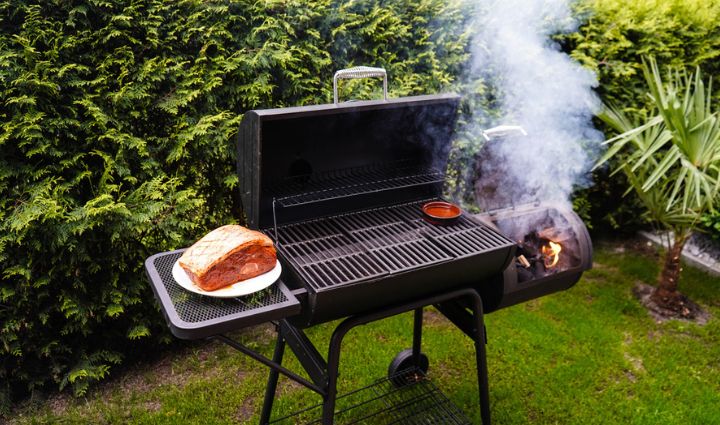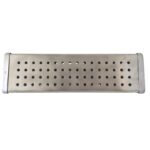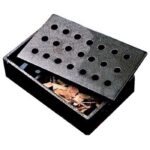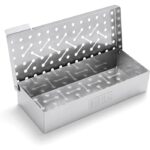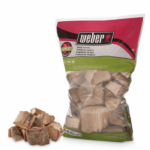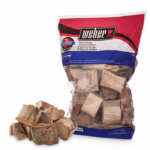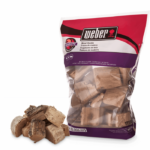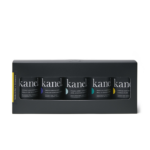Whether you dream of slow-smoked ribs, juicy brisket, or perfectly tender pulled pork, the right smoker can make all the difference. But with so many types of smokers available, how do you choose the one that fits your needs?
Smokers come in various styles and can be categorized in two ways.
- By fuel source, including pellet smokers, propane/gas, charcoal, and electric smokers. Each fuel source offers unique benefits and challenges—keep reading to learn more about the pros and cons of each.
- By construction style, including offset, vertical, bullet, and drum smokers. Each style differs in design, space efficiency, and cooking method.
The best smoker for you depends on your experience level, cooking preferences, and how much hands-on involvement you want. If you’re a beginner, electric smokers offer a simple, set-it-and-forget-it approach. Charcoal and wood smokers provide unbeatable results if you’re chasing that deep, authentic barbecue flavor, but they require more skill to master.
In this guide, we’ll break down the different types of smokers, explaining how they work, their pros and cons, and when you should consider buying each one. By the end, you’ll clearly understand what type of smoker you should buy based on your BBQ goals. We’ll look closer at 10 different types of smokers:
- Propane/gas smokers
- Charcoal or wood smokers
- Electric smokers
- Pellet smokers
- Offset smokers
- Vertical smokers
- Bullet smokers
- Drum smokers
- Kamado grills
- Kettle grills
Let’s dive in!
1. Propane/Gas Smokers
Propane smokers, also known as gas smokers, are a popular choice for beginners and those who want a hassle-free smoking experience. Most propane smokers are built in a cabinet-style design, with a burner and air vents at the bottom and a chimney or dampers at the top to regulate airflow and circulate smoke. Unlike charcoal or wood smokers, propane smokers rely on gas as their primary fuel source, making them quick to start and easy to control.
How does a propane smoker work?
A propane smoker channels gas from a propane tank or natural gas line through a manifold to the cooking chamber. The gas ignites as it flows through burner valves, generating heat to cook the food.
Because propane does not produce smoke, you’ll need a wood chip tray or smoker box to add smoky flavor. When you place wood chips or chunks near the burner, the heat will cause them to smolder, thus infusing your food with a subtle, smoky taste.
Pros
- Easy to use – A propane smoker requires minimal effort to start and maintain, making it ideal for beginners.
- Fuel is widely available – Propane tanks are easy to find at gas stations, hardware stores, and supermarkets.
- Temperature control is simple – Adjusting the heat is as easy as turning a knob, unlike charcoal smokers that require manual airflow adjustments.
- Faster startup time – Heats up quickly compared to charcoal or wood-burning smokers.
Cons
- Less smoke flavor – Since propane doesn’t produce smoke naturally, the flavor may not be as deep or complex as with charcoal or wood smokers.
- High fuel consumption – A propane smoker can burn through a lot of fuel, especially during long smoking sessions.
- Limited temperature range – While great for low-and-slow cooking, propane smokers may not reach the higher temperatures needed for some barbecue styles.
When to buy a propane smoker
- You want an easy-to-use smoker with a minimal learning curve.
- You prefer quick startup and consistent temperature control.
- You need a portable smoker that doesn’t require electricity.
- You have a lower budget but still want an effective smoking solution.
Shop for smoker boxes:
2. Charcoal Smokers
Charcoal smokers are the gold standard for authentic BBQ flavor, producing deeper and richer smoke than gas, electric, or pellet smokers. But this top-notch flavor comes with a trade-off—charcoal smokers require the most effort and can have a steep learning curve.
How does a charcoal smoker work?
Charcoal smokers use air intake vents near the firebox and on the lid to regulate heat. The more oxygen is allowed in, the hotter the coals will burn. Wood chunks or chips can also be placed within the charcoal to smolder and enhance the smoke flavor even more.
The food sits above the burning coals, while a chimney or exhaust vent at the top helps draw smoke and heat through the cooking chamber, enveloping the meat in rich, smoky flavor. Controlling heat and smoke can be challenging—understanding how to use vents effectively is key to mastering a charcoal smoker. (Check out our guide to venting for our expert tips.)
Pros
- Best smoky flavor – Provides deep, complex smoke flavor that gas, electric, and pellet smokers can’t fully replicate.
- Variety of styles and sizes – Available as bullet smokers, kettle grills, kamado grills, and gravity-feed smokers.
- Versatile cooking temperatures – Can be used for both high-heat grilling and low-and-slow smoking.
- Charcoal is widely available – No need for propane tanks or electrical outlets.
Cons
- Steep learning curve – Requires practice to maintain steady heat and smoke levels.
- Takes time to heat up – Charcoal needs time to ignite and reach the desired temperature.
- More cleanup required – Produces ash that needs to be emptied after each cook.
When to buy a charcoal smoker
- You’re a serious BBQ enthusiast who enjoys being hands-on from start to finish.
- You want an authentic, rich, smoky flavor that other smokers can’t match.
- You enjoy the process of fire management and tweaking airflow to control temperature.
- You don’t mind the extra setup, learning curve, and cleanup that come with charcoal cooking.
3. Electric Smokers
If you’re looking for a set-it-and-forget-it smoking experience, an electric smoker is your best bet. Unlike charcoal, gas, or wood smokers, electric smokers (including popular pellet smokers) rely on a heating element instead of an open flame, making them the easiest and most low-maintenance option. These smokers are perfect for beginners, requiring minimal effort while delivering delicious smoked meats.
Most electric smokers are built vertically, with a heating element at the bottom and a wood chip tray and water pan positioned between the heat source and the food racks. The wood chip tray adds smoky flavor, while the water pan helps regulate temperature and creates moisture, enhancing the smoky flavor and preventing food from drying out.
How does an electric smoker work?
Electric smokers generate heat using an electrical heating element rather than burning charcoal, wood, or propane. To create smoke, wood chips are placed above the heating element, where they smolder and release flavor into the cooking chamber. The water pan helps maintain steady temperatures and keeps the environment humid, which is great for tender meat (but not so great for creating a crisp bark or smoke ring).
Pros
- Easiest to use – Great for beginners, with no need to manage fire or refuel constantly.
- Low operating costs – Doesn’t require additional fuel beyond electricity.
- Ideal for residential areas – No open flame, making it a great choice for places with fire restrictions.
Cons
- Less smoky flavor – Without combustion, the smoke flavor is milder compared to charcoal or wood-burning smokers.
- No smoke ring – Lacks the high heat and combustion necessary to create that sought-after pink smoke ring.
- Moist cooking environment – The water pan prevents meat from drying out but can make it harder to get a crispy bark.
- Not weatherproof – Electrical components must be kept dry, requiring storage under cover or a waterproof smoker cover.
- Repairs can be difficult – Electrical parts may not be as easy to fix or replace as traditional smoker components.
When to buy an electric smoker
- You prefer a hands-off smoking experience with precise temperature control.
- You have access to an electrical outlet and want a hassle-free option.
- You live in a residential area with fire restrictions prohibiting charcoal or wood smoking.
4. Pellet Smokers
Offering wood-smoked flavor with push-button convenience, pellet smokers are an excellent choice for anyone who wants an easy, reliable smoking experience.
These smokers operate on electricity and wood pellets, combining the best aspects of wood-fired flavor with modern automation. With a “set-and-forget” design, all you need to do is plug it in, load the pellet hopper, set your desired temperature, and let the smoker do the rest. Plus, unlike traditional smokers, a pellet smoker can also function as an oven or grill, adding to its versatility.
How does a pellet smoker work?
Pellet smokers use small, compressed wood pellets made from sawdust as fuel. The pellets are added to a hopper on the side of the smoker and fed into a firebox by an automated auger. Inside the firebox, a heated metal rod ignites the pellets, creating both heat and smoke, which then circulates through the cooking chamber.
The smoker maintains consistent heat by adjusting airflow and pellet feed rate. On high-end models, an internal probe measures temperature and automatically adjusts pellet flow, but lower-end models will rely on a manual setting that requires some monitoring to maintain steady temperatures.
Pros
- Authentic wood-smoked flavor – Delivers great smoke flavor without the hassle of managing a fire.
- Set-and-forget operation – No need to constantly check temperatures or refuel like charcoal or propane smokers.
- Versatile cooking options – Can smoke, grill, roast, and even bake, making it a true all-in-one outdoor cooker.
- Minimal cleanup – Pellets burn cleanly, leaving very little ash; just vacuum out the firebox every few cooks.
Cons
- Expensive upfront cost – Even entry-level pellet smokers tend to be pricier than other smokers.
- Requires electricity – Pellet smokers must be plugged in, which can limit placement options.
- Not very portable – Bulky and not ideal for tailgating or camping without a power source.
- Pellet costs add up – While efficient, they can be more expensive over time than charcoal or propane.
When to buy a pellet smoker
- You want an all-in-one outdoor cooker to smoke, grill, roast, and bake.
- You prefer an automated smoking experience with precise temperature control.
- You don’t mind relying on electricity and purchasing wood pellets as fuel.
5. Offset Smokers
Offset smokers, also known as horizontal smokers, are among the most traditional and well-known smoker designs. Originally created using repurposed oil drums, these smokers use charcoal and wood as fuel, delivering unmatched smoke flavor. While some models can double as grills, they primarily create low-and-slow, wood-smoked barbecue using indirect heat.
How does an offset smoker work?
The name “offset” comes from the position of the firebox, which is located to the side and slightly below the main cooking chamber. As charcoal or wood burns in the firebox, smoke and heat are drawn across the food, slowly cooking it before exiting through a chimney on the opposite side.
Some offset smokers may also use a diffuser that runs the length of the cooking chamber. This helps distribute heat and smoke more evenly, preventing hot spots and ensuring consistent cooking.
What about reverse flow offset smokers?
Reverse flow smokers are a variation of the standard offset smoker. These smokers use a series of baffles to force heat and smoke to travel under and then over the food before exiting through a chimney above the firebox. This setup helps maintain more even temperatures and enhances smoke infusion.
Pros
- Most traditional wood-fired smoking experience – Provides the richest, most authentic BBQ flavor.
- Large cooking capacity – The barrel-style chamber allows for smoking multiple racks of ribs, briskets, or even whole hogs.
- Firebox placement allows easy refueling – You can add charcoal or wood without losing heat and smoke in the cooking chamber.
Cons
- Expensive upfront cost – Cheap offset smokers often have poor heat retention, so a quality model is essential.
- Takes time to heat – Plan for at least an hour to reach ideal smoking temperatures.
- Requires constant monitoring – You’ll need to manage the fire throughout the entire cooking process.
- Bulky and heavy – Offset smokers take up a lot of space and are difficult to move.
When to buy an offset smoker
- You are willing to invest time in learning fire and temperature control.
- You need a large cooking capacity for smoking multiple meats at once.
- You want to master traditional wood-fired smoking and achieve competition-level BBQ flavor.
6. Vertical/Upright Smokers
Vertical smokers, also known as box smokers or upright smokers, are a space-saving alternative to traditional offset smokers. They function similarly, but the heat and smoke source is directly beneath the cooking chamber instead of a side-mounted firebox. This design speeds up cooking while maintaining consistent heat and smoke circulation.
Vertical smokers are available in gas, electric, and charcoal-fueled models, making them one of the most versatile smoker types.
How does a vertical smoker work?
A vertical smoker consists of three compartments:
- Bottom chamber – Holds the heat source, which could be charcoal, wood, gas, or an electric element.
- Middle chamber – Contains a water pan that regulates heat and prevents food from drying out.
- Top chamber – The main cooking area, where racks of meat, poultry, or fish are placed.
Heat and smoke rise naturally through the chambers, infusing food with flavor and cooking it efficiently. The upright design creates a steady flow of heat and smoke, leading to faster cook times than an offset smoker.
Pros
- Space-efficient – The upright design takes up less space without sacrificing much cooking capacity.
- Versatile cooking options – Can be used for baking, roasting, and even making pizzas.
- Good heat and smoke circulation – The vertical setup ensures even cooking.
Cons
- Cannot be used for grilling – Strictly a smoker, not a multi-functional grill.
- Large chambers take time to heat up – Though more efficient than an offset smoker, the cooking area still requires preheating.
- Limited space for large cuts of meat – Tall but narrow cooking racks can be restrictive.
- Requires refueling – Whether you use charcoal, propane, or wood, the fuel source must be replenished periodically.
When to buy a vertical smoker
- You have limited patio or backyard space but still want a capable smoker.
- You want an efficient smoker with good heat and smoke circulation.
- You prefer a more affordable option that still delivers solid smoking performance.
7. Bullet Smokers
Bullet smokers, also known as vertical water smokers, are a small, sleek, and budget-friendly option for those who want great smoke flavor without a large, complex setup. They share the same basic configuration as larger vertical smokers, but their compact size makes them ideal for small patios, balconies, or even portable use.
Unlike electric or pellet smokers, bullet smokers have no electrical or mechanical components, making them easy to use and maintain.
How does a bullet smoker work?
Like vertical smokers, bullet smokers are made up of three sections:
- Bottom chamber – Holds charcoal and wood chunks, providing the heat and smoke.
- Middle chamber – Houses a water pan, which helps regulate temperature and keeps food moist.
- Top chamber – The cooking area, where vents at the top and bottom control airflow and heat.
Because water is essential for stabilizing temperatures in a bullet smoker, keeping the pan filled is key to using it effectively.
Pros
- Small and compact – Takes up little space and fits on patios, decks, and balconies.
- Portable – Lightweight enough to bring to camping trips or tailgating events.
- Excellent smoke flavor – Produces deep, authentic smoky flavor like larger charcoal smokers.
Cons
- Limited cooking capacity – Small size means it’s not ideal for large BBQs or smoking big cuts of meat.
- Single-use design – A dedicated smoker that can’t be used for grilling or other cooking methods.
- Temperature control can be tricky – Requires manual airflow adjustments to maintain steady heat.
When to buy a bullet smoker
- You want an affordable, compact, and easy-to-use smoker.
- You are just starting out with smoking, but still want that rich smoky flavor.
- You need a portable smoker for camping, tailgating, or small-space cooking.
8. Drum Smokers
Drum smokers, sometimes called “Ugly Drum Smokers” (UDS), are no-frills, fuel-efficient smokers that deliver excellent results with minimal effort. These smokers are essentially steel barrels modified with grilling racks, a charcoal basket, air vents, and a chimney. Ready-to-use models are available, but DIY BBQ enthusiasts might enjoy building their own by retrofitting a 55-gallon steel drum.
How does a drum smoker work?
A drum smoker operates with a firebox at the bottom, filled with charcoal and wood chunks to generate heat and smoke.
A grate sits about a foot above the firebox, with a lid that seals tightly to retain heat and smoke.
Many drum smokers also include meat hooks, allowing you to hang ribs, brisket, or poultry in the center of the drum. As the juices drip onto the hot coals, they vaporize and infuse the meat with even more flavor.
Air vents at the base and lid help regulate airflow and temperature. Due to the compact, well-sealed design, drum smokers can hold steady temperatures for up to 12 hours without requiring additional charcoal.
Pros
- Compact and great for small spaces – A space-saving option that doesn’t take up much room.
- Holds steady temperatures – Fuel-efficient design allows for long, consistent cooks.
- Minimal babysitting required – Once dialed in, it requires little intervention.
- Affordable – Tends to be cheaper than other smoker types, especially if DIYed.
Cons
- Rough appearance – The “Ugly Drum Smoker” nickname exists for a reason—it's not the most stylish option.
- Limited capacity – While effective, it doesn’t hold as much food as offset or vertical smokers.
- Refueling can be tricky – Since the charcoal sits beneath the meat, adding more fuel requires careful maneuvering.
- Lacks precise temperature control – Airflow adjustments help, but it's not as precise as pellet or gas smokers.
When to buy a drum smoker
- You want a fuel-efficient smoker that maintains steady temperatures with little effort.
- You enjoy a simple, no-frills smoking experience with great results.
- You like the idea of modifying or building your own smoker from a steel drum.
9. Kamado Grills
Kamado grills are high-end, ceramic smokers known for their incredible heat retention, versatility, and durability. Unlike traditional smokers, they have thick ceramic walls and a distinctive egg shape that helps trap heat and moisture, making them excellent for smoking, grilling, baking, and roasting.
The Big Green Egg (BGE) is the most well-known kamado-style smoker, but several brands offer similar designs. These grills are built to last a lifetime, making them a long-term investment for serious BBQ enthusiasts.
How does a Kamado grill work?
A kamado grill works similarly to other charcoal smokers, but its ceramic design provides superior insulation. The egg-shaped design also directs heat and smoke back over the food, improving flavor absorption and cooking efficiency.
Fire produces heat at the bottom of the cooking chamber, food sits on a grill grate above the fire, and vents at the top and bottom regulate airflow and temperature. You’ll also need wood chips and a water pan to infuse food with smoky flavor and maintain moisture when smoking on a Kamado grill.
Pros
- Excellent heat and moisture retention – Less airflow means less risk of food drying out.
- Multi-purpose cooker – Can smoke, grill, bake, and roast, making it one of the most versatile smokers.
- Superior insulation – Thick ceramic walls provide great heat retention, especially in cold weather.
- Extremely durable – Designed to last a lifetime, making it a solid long-term investment.
- Compact design – Doesn’t take up much space, making it ideal for patios and smaller outdoor areas.
Cons
- Expensive – The high-quality ceramic build comes with a hefty price tag.
- Temperature control can be tricky – Once the ceramic walls heat up, it’s hard to lower the temperature quickly if you overshoot.
- Fire location makes refueling difficult – Adding more charcoal mid-cook and cleaning out ash can be challenging.
- Learning curve – Mastering vent control and temperature management takes practice.
When to buy a Kamado grill
- You want a durable, high-quality smoker that can also grill and bake.
- You appreciate superior heat retention and efficiency, especially for long cooks.
- You don’t mind the higher price tag for long-term value and exceptional performance.
10. Kettle Grills
Kettle grills are versatile, affordable outdoor cookers that can double as smokers with the right setup. While they’re primarily designed for grilling, a basic charcoal kettle grill can be easily adapted for low-and-slow smoking using techniques like the snake method or C-ring coal arrangement.
For casual BBQ enthusiasts who don’t want to commit to a dedicated smoker, kettle grills offer a cost-effective way to experiment with smoking while still providing the convenience of traditional grilling.
How does a kettle grill work as a smoker?
To use a kettle grill as a smoker, you need to create indirect heat by arranging the coals and wood chunks strategically in a C-ring or snake formation along one side of the grill. Wood chunks are placed on top of the coals to produce smoke as the coals light, and a water pan is placed near the coals to regulate heat and add moisture. Food should then be placed on the opposite side of the coals, allowing indirect heat and smoke to cook the meat.
The airflow system is key to maintaining proper heat and smoke circulation. Air enters through the vent at the base, flows over the coals, wood chunks, and water pan, and exits through the exhaust vent at the top.
GRILL SPOT TIP: Start with the vents ¼ open and adjust as needed to control temperature. Check out our venting guide for more tips.
Pros
- Great for multi-purpose use – Perfect for people who already own a kettle grill and want to try smoking.
- No modifications required – No need to make structural changes to the grill.
- Affordable and widely available – Charcoal kettle grills are among the most budget-friendly outdoor cookers.
- Compact and portable – Easy to transport and ideal for small outdoor spaces.
Cons
- Not designed specifically for smoking – Requires creative setup and careful management of airflow.
- Temperature control can be tricky – Takes time to master vent adjustments for indirect heat.
- Charcoal requires cleanup – Ash and used coals will need to be emptied after each use.
- Limited cooking space – Small size makes it difficult to smoke larger cuts of meat or large quantities at once.
When to buy a kettle grill for smoking
- You want an affordable grill that can double as a smoker with proper setup.
- You need a compact and portable option for occasional smoking.
- You are looking for a versatile outdoor cooker without committing to a dedicated smoker.
Shop for wood chunks:
Factors To Consider When Deciding What Type of Smoker You Should Buy
With so many different types of smokers available, choosing the right one comes down to your budget, experience level, cooking style, and desired features. Before making a purchase, here are the key factors to consider when selecting the best smoker for your needs:
- Budget: Smokers come in a wide range of prices, from affordable entry-level models to high-end competition-style cookers. Charcoal, propane, and electric smokers (except premium ceramic models like the Big Green Egg) are the most affordable options. Pellet smokers offer more automation and versatility at a mid-range price. Offset smokers, kamado grills, and high-end pellet smokers require a more significant investment, but they offer exceptional durability and performance.
- Effort & Ease of Use: Propane and electric smokers are the easiest to use, requiring little to no babysitting. Pellet smokers offer a balance between convenience and control, allowing you to fine-tune the smoking process without managing a fire manually. Charcoal and offset smokers require fire management skills, frequent monitoring, and more hands-on adjustments, making them better suited for experienced users.
- Size & Cooking Capacity: Offset smokers are ideal for cooking large quantities of meat at once, perfect for BBQ competitions or feeding big crowds. Vertical smokers, bullet smokers, and kettle grills are great for small patios and backyards while still providing enough room for a household-sized cook.
- Flavor & Fuel Type: Charcoal and offset smokers produce the richest, most complex smoky flavors. Pellet smokers create a consistent, wood-smoked taste but don’t always reach the depth of charcoal or wood-burning models. Electric and propane smokers provide a lighter smoke profile, making them ideal for those who prefer a more subtle smokiness.
- Ventilation & Airflow Control: Offset, kamado, and drum smokers offer more airflow adjustment options, allowing you to fine-tune heat and smoke levels. Lower-end smokers (especially budget-friendly models) often have fewer venting options, making it harder to control temperature precisely.
- Maintenance & Cleanup: Electric and propane smokers require minimal cleaning as they don’t produce much ash. Pellet smokers burn efficiently, leaving behind only small amounts of ash. Charcoal and offset smokers generate the most ash buildup, requiring frequent cleanup. Look for removable ash catchers, grease management systems, and easy-access cleaning features to make maintenance easier.
- Additional Features: Consider whether you need special features like built-in thermometers or digital temperature controls for precise heat monitoring, multiple cooking racks for increased capacity, access doors to easily refuel the fire without disturbing the cooking chamber, or even Wi-Fi or Bluetooth connectivity (available on high-end pellet smokers) for remote monitoring.
Types of Smokers: Find the Best One for Your BBQ Style
Choosing the right smoker depends on your budget, experience level, and BBQ goals. Whether you’re looking for a set-it-and-forget-it electric smoker, the rich, smoky flavor from a charcoal or offset smoker, or an all-in-one pellet smoker, there’s a perfect option for every type of cook.
For beginners, propane and electric smokers offer an easy, hassle-free smoking experience. If authentic smoke flavor is your top priority, charcoal and offset smokers provide unmatched results, though they require more hands-on effort. And if versatility matters most, pellet smokers and kamado grills offer multiple cooking options in one unit.
Before you buy, consider factors like cost, size, ventilation, and maintenance to find the best fit for your needs. No matter which smoker you choose, the most important part is enjoying the process and making great BBQ!
Shop for BBQ salts:
Sources
- “7 Types of Smokers (And Which One You Should Buy)“. Smokedbbqsource. Joe Clements. May 15, 2024.
- “Common Types of BBQ Smokers“. grillbilliesbarbecue.com.
- “Different Types Of Barbecue Smokers“. bbqgalore.com.
- “Types of Smokers“. September 9, 2024. smokingmeatgeeks.com.
- “Types of Smokers“. chiassonsmoke.com.

